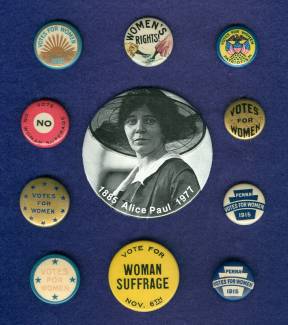Collection Name
About
The following article, by Albert Feldstein, appeared in the APPA (Association for the Preservation of Political Americana) Standard, Volume III, Number 2, Summer 1976.
Cause Movements in America
Suffrage and Beyond: A Two-Part Synopsis of the Women's Movement
It was early morning on the day of August 26, 1920, Bainbridge Colby, then Secretary of State under Woodrow Wilson (1856-1924), had just issued the proclamation certifying the ratification of the Nineteenth Amendment to the Constitution. For twenty-six million Americans, the right to vote became law.
The long and bitter struggle for enfranchisement spanned seven decades. Although there had been intermittent stirrings of a women's movement in America since 1800, the organized struggle for women's suffrage did not come into existence as a recognizable phenomenon until the Seneca Falls Convention of 1848. Originally conceived to remedy a variety of inequalities, such as slavery, the convention quickly placed the emphasis on women's suffrage as the best means to secure these other reforms. The credit for this first advocacy of women's rights can be directly attributed to the efforts of America's pioneer suffragette, and organizer of the Seneca Falls Convention, Elizabeth Cady Stanton (1815-1902). Citing mankind's history as one of "repeated injuries and usurpations on the part of man toward women, having in direct object the establishment of an absolute tyranny over her", and stating that, "It is the duty of women of this country to secure to themselves their sacred right to the elective franchise", Mrs. Stanton, against some opposition, succeeded in obtaining the convention's approval of a resolution calling for women's suffrage. In 1851, Mrs. Stanton would be joined in her efforts by Susan B. Anthony (1820-1906), probably the most well known of America's suffragettes. It was to be a working partnership and personal friendship that would last the rest of their lives.
During these early years, the women's suffrage movement and anti-slavery forces closely paralleled each other in their efforts to secure equality. The Civil War, and eventual freeing of the slaves, ended this mutual cooperation. Many people began to see the struggle for women's suffrage as a threat to the black man's securement of the franchise. The women's movement soon found opposition not only from long time supporters, but from within their own ranks as well. Unwilling to compromise their objectives, Elizabeth Cady Stanton and Susan B. Anthony in 1869 divided the movement by forming the radical National Woman Suffrage Association (NWSA). In opposition to this, came into existence the American Woman Suffrage Association (AWSA), which promoted the primacy of black suffrage. The separation lasted twenty years. In 1890, with the ideological differences and obstacles overcome, the two organizations merged into the National American Woman Suffrage Association (NAWSA), with Elizabeth Cady Stanton as president.
Though the spiritual and physical leadership of the early suffragettes can never be denied, the movement had made only small gains by the turn of the century. At the time of Mrs. Stanton's death in 1902, and Susan B. Anthony's death in 1906, only four states had granted the vote to women.
By 1913, a major rift had again developed within the movement. The younger suffragettes, having become dissatisfied and impatient with the conservative leadership of NAWSA, reorganized into a new group. First called the Congressional Union, and later the National Woman's Party, this new organization was led by Alice Paul (1885-1977).
When Alice Paul returned home in 1912 from a lengthy stay in England, the influence of the militant English suffrage movement on her developing strategies soon became apparent. Adapting the radical tactics used by the famous English suffragette leaders, Emmeline (1858-1928) and Christabel Pankhurst (1880-1958), Alice Paul and her followers concentrated their efforts on the passage of a nationwide suffrage amendment. The NWP greatly intensified the effort for women's suffrage with a style calculated to acquire public sympathy and arouse (or embarrass) the Congressional conscience. Suffragettes picketed in Washington every day from January 1917 until July 1918. They marched and demonstrated. They were arrested and imprisoned, whereupon they fasted and were painfully force fed in many instances.
To this day, Wilson biographers differ as to what affect this new tactic had on his decision to support the amendment in January of 1918. In any event, the 19th Amendment passed the Congress the following year, and was ratified in time for the national election of 1920.
----
Included within the buttons on this page is a anti-suffrage button. There was opposition to giving women the vote. Aside from the biological differences, reasons included that women were too frail to withstand the rigors of going to the polls and being jostled about, and possibly insulted. It was felt that a woman's place was in the home and to take care of the family, and that they needed to remain pure and decent. Women were also felt to be "vulnerable", open to exploitation, and that this could lead us into war.
The right for women to vote had been placed on the ballots of several individual states for some years prior to the 19th Amendment. A 1915 referendum in Pennsylvania, as portrayed in the button above, resulted in a vote of "No" on women's suffrage. Pennsylvania did, however, ratify the 19th Amendment on June 10, 1919. The State of Maryland, having rejected the 19th Amendment on February 24, 1920, would not ratify the amendment until March 19, 1941, with the ratification not being certified until February 25, 1958. The 19th Amendment simply states, "The right of citizens of the United States to vote shall not be denied or abridged by the United States or by any State on account of sex."
